BRDM-2
| BRDM-2 | |
|---|---|
|
BRDM-2 on a military parade, 1 March 1983. | |
| Type | Amphibious Armoured Scout Car |
| Place of origin | Soviet Union |
| Service history | |
| In service | 1962–present |
| Used by | See Operators |
| Wars | See Service History |
| Production history | |
| Designer | V. K. Rubtsov |
| Manufacturer | Gorkovsky Avtomobilny Zavod (GAZ) in Nizhny Novgorod |
| Produced | 1962–1989[1] |
| Number built | 7,200[1] |
| Variants | See Variants |
| Specifications | |
| Weight | 7 tonnes (7.7 short tons; 6.9 long tons)[2] |
| Length | 5.75 m (18 ft 10 in) |
| Width | 2.37 m (7 ft 9 in)[3] |
| Height | 2.31 m (7 ft 7 in) |
| Crew | 4 (driver, co-driver, commander, gunner) |
|
| |
| Armor |
Welded steel 10 mm turret front[4] 7 mm turret sides, rear and top[2] 14 mm hull nose plate[2] 5 mm hull, upper front[2] 7 mm hull lower front, sides, rear and top[2] 2 mm hull front floor[2] 3 mm hull rear floor[2] |
Main armament | 14.5 mm KPVT heavy machine gun (500 rounds)[2] |
Secondary armament | 7.62 mm PKT coaxial general-purpose machine gun (2,000 rounds)[2] |
| Engine |
GAZ-41 gasoline V-8 140 hp (104 kW) at 3,400 rpm[1] |
| Power/weight | 18.2 hp/tonne (13.5 kW/tonne) |
| Suspension | Wheeled 4x4 (+ 4 auxiliary wheels), leaf springs with hydraulic shock absorbers |
| Ground clearance | 430 mm (17 in)[2] |
| Fuel capacity | 290 l (64 imp gal; 77 US gal)[2] |
Operational range | 750 km (470 mi) |
| Speed |
100 km/h (62 mph) (road) 10 km/h (6.2 mph) (water)[2] |
The BRDM-2 (Boyevaya Razvedyvatelnaya Dozornaya Mashina, Боевая Разведывательная Дозорная Машина, literally "Combat Reconnaissance/Patrol Vehicle"[5]) is an amphibious armoured patrol car used by Russia and the former Soviet Union. It was also known under the designations BTR-40PB, BTR-40P-2 and GAZ 41-08. This vehicle, like many other Soviet designs, has been exported extensively and is in use in at least 38 countries. It was intended to replace the earlier BRDM-1, compared to which it had improved amphibious capabilities and better armament.
History
After a few years of use by the Soviet Army, the limitations and drawbacks of the BRDM-1 became obvious. The vehicle had no turret and to operate the armament the gunner had to open a hatch and expose himself to enemy fire. The vehicle was not fitted with an NBC protection system, and had no night vision equipment by default. The vehicle also didn't have any kind of special sights, which undermined its usability as a reconnaissance vehicle. These drawbacks encouraged the design team to create a new vehicle which would suit the modern battlefield.[1]
Construction
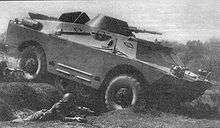
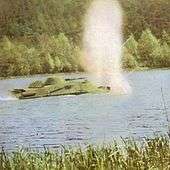

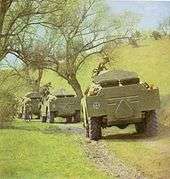

The BRDM-2 has a crew of four; a driver, a co-driver, a commander, and a gunner. It has two pairs of chain-driven belly wheels lowered by the driver, which allow trench crossing just like its predecessor, and a centralized tire pressure regulation system, which can be used to adjust the tire pressure of all four tires or individual tires while the vehicle is in motion to suit to the ground conditions.[1][2]
Externally, it differs from the BRDM-1 by having a larger, box-like hull. It retains the boat-like bow of the BRDM-1. However, the crew compartment is now further forward and the new GAZ-41 gasoline V-8 engine is in the rear. Thanks to this, the engine is much better protected from enemy fire. The engine compartment is also separated from the crew compartment by an armoured barrier.
The driver's and commander's stations are in the front of the vehicle, with the driver positioned on the left and commander on the right. Both of them sit in front of a bulletproof windscreen, which provides them with their primary view of the battlefield. When in combat, the windscreen can be additionally protected by twin armoured shutters. When the shutters are in their opened position, they protect the driver and commander from being blinded by the sunlight and ensure that the windscreen won't be blurred by rain or snow. The commander and driver have periscopes allowing both of them a more detailed view of the surrounding terrain. The commander has six TNP-A periscopes (five in the front and one on the side of the vehicle), a TPKU-2B day sight and a TKN-1 night sight. The driver has four TNP-A periscopes (all in the front), one of which can be replaced by a TWN-2B night vision device. The gunner is in the turret during combat, but when traveling he is seated inside the hull.
The crew mounts and dismounts the vehicle via two hatches over driver's and commander's stations. On either side of the hull adjacent to the crew position, there is a firing port. Immediately behind the firing port there are three TNP-A periscopes, which protrude from the outside of the hull, giving the crew some vision to the front and rear of the vehicle.[1]
The engine is larger than the BRDM's (it is a 140 hp V-8 instead of a 90 hp 6-cylinder). The BRDM-2 has an IR spotlight and four IR driving lights, as well as an over pressure collective NBC filter system. The IR spotlight is located on top of the commander's periscope. The vehicle also has an R-123 radio and an antenna on the right side of the hull next to the commander's hatch, for communication. There's also a winch mounted internally at the front hull that has a 30 m cable and a 4 tonne capacity. The winch is intended to be used, among others, for self-recovery when stuck in difficult terrain. A spare tire can be mounted on top of the turret. This was most often practiced by Polish crews.[1][2]
Like its predecessor, the BRDM-2 is amphibious. The GAZ-41 gasoline V-8 engine supplies power to the circular water-jet, equipped with a four-bladed propeller at the rear of the vehicle, which is covered with an armoured shutter while on land. This shutter must be removed before entering water. The water-jet allows amphibious travel with a speed of 10 km/h for 17 to 19 hours. A trim board, which is stowed under the nose of the hull when traveling, is erected at the front of the hull before entering the water to improve the vehicle's stability and displacement in the water and to prevent the water from flooding the bow of the BRDM-2. While in its traveling position, it serves as additional armour.
Armament
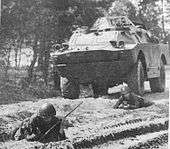
The armament is the same as the BTR-60PB armoured personnel carrier; a 14.5 mm KPVT heavy machine gun with a coaxial 7.62 mm PKT general-purpose machine gun as a secondary weapon, both in a small conical BPU-1 turret mounted on the hull in a central position above the belly wheels.[1]
The 14.5 mm KPVT heavy machine gun has a practical rate of fire of 150 rounds per minute and a cyclic rate of fire of 600 rounds per minute. It has an effective range during daylight operations of 2,000 m. It can penetrate 20 mm of armour at a range of 1,000 m and 30 mm of armour at a range of 500 m. It can also fire at air targets, in which case the tactical range is 1,400 m. It uses the 14.5 mm API-T, 14.5 mm I-T, 14.5 mm HE-T, 14.5 mm and MDZ type ammunition.
The 7.62 mm PKT coaxial general-purpose machine gun has an effective range during day time operations of 1,000 m while the vehicle is stationary and from 400 m to 500 m while the vehicle is on the move. It is fired in 2 to 10 round bursts and has a practical rate of fire of 250 rounds per minute and a cyclic rate of fire of 650 rounds per minute. During daylight operations, the gunner uses the PP-61AM sight, which has a field of view of 23 degrees and x2.6 magnification.[1]
The BPU-1 turret is unusual because it has no top hatch opening. Contrary to the popular belief, the BPU-1 turret was originally designed for the BRDM-2. The turret was later used in the Soviet BTR-60PB, the Polish SKOT-2A and the Czechoslovak OT-64A. The turret allows the armament to be elevated between −5 and +30 degrees. On the left side of the turret, there is an air inlet on the hull top. There are also two air-inlet louvers in the forward part of the engine compartment's roof and four smaller air-inlet louvers to the rear. Both sides have centrally placed vision blocks.
The vehicle armor, which is composed of welded steel, protects it fully against small arms fire and small shell fragments; but doesn't protect it against big artillery fragments or .50-calibre machine gun fire, which can penetrate the BRDM-2's maximum armor of 14 mm. The BRDM-2-series tires are not protected by armour and are particularly vulnerable to puncture from fire of all kinds.[1][2]
There are three different production lots, which have different cooling vents on the engine deck. The late production version has mushroom-type vents. It also has slightly modified turret and can elevate its armament to +60 degrees. Final production BRDM-2s have additional turret periscopes and a TNA-2 navigation apparatus.[1][4]
Variants

BRDM-2 has flaws that are also apparent in other Soviet vehicles. These include the poor ergonomic design, low level of crew protection and high fuel consumption. The ergonomics was addressed in the Polish BRDM-2M-96 modernization and its successors, the BRDM-2M-96i, BRDM-2M-96ik "Szakal", BRDM-2M-96ik "Szakal Plus", BRDM-2M-97 "Żbik-B", BRDM-2M-97C "Żbik-P" and BRDM-2M-98 "Żbik-A", which all had the belly wheels removed, thus providing more space for the crew or space for two soldiers. This was also carried out in Morozov's BRDM-2SMD.[1]
The BRDM-2 has a unique flaw. Because the only way in and out of the vehicle is via the front hatches, leaving the vehicle while in combat is almost impossible, as the exiting crew members would instantly enter the line of fire of both the enemy and its own vehicle, as hatches are positioned directly in front of the turret. This shortcoming was addressed in the Polish BRDM-2M-96 modernization and its successors, the BRDM-2M-96i, BRDM-2M-96ik "Szakal", BRDM-2M-96ik "Szakal Plus", BRDM-2M-97 "Żbik-B", BRDM-2M-97C "Żbik-P" and BRDM-2M-98 "Żbik-A", all of which have side hatches. This was also done in the Czech LOT-B and OKV-P as well as the Ukrainian BRDM-2SMD. The Polish BRDM-2M-97 "Żbik-B", BRDM-2M-97C "Żbik-P" and BRDM-2M-98 "Żbik-A" also have a hatch on the top of the turret, giving the crew another way out.
The BRDM-2's predecessor, BRDM-1, didn't have that issue as the BRDM-1 obr. 1957 had no roof and later models had a rear hatch that allowed the crew to exit the vehicle from behind. The fact that the BRDM-2 is missing such a hatch is a consequence of putting the engine in the rear, unlike in BRDM-1 where the engine is in the front.[1]
The BRDM-2 is sometimes confused with the Hungarian D-442 FUG and D-944 PSzH amphibious scout cars, which also have rear-mounted engines. What distinguishes them from the BRDM-2 is that they have twin waterjets, whereas the BRDM-2 has a single triangular water jet.
Service history
Soviet Union and Russia
The BRDM-2 entered service with the Soviet Army in 1962. It was first publicly shown in 1966. It has replaced the BRDM-1 in the Soviet and Warsaw Pact armies. Production started in 1962 and went on until 1989, with 7,200 vehicles produced (mostly for export).
The BRDM-2 became famous for being the vehicle selected to pull Brezhnev's coffin during the funeral ceremony in the Red Square.
Poland

Poland bought 450 BRDM-2 armoured scout cars, 418 9P133 "Malyutka" and 9P148 "Konkurs" tank destroyers and 32 BRDM-2RS NBC reconnaissance vehicles in 1965. Later, Poland obtained some 9P31 Surface-to-air missile launchers. In 2004, the Polish Army operated 600 BRDM-2 armoured scout cars and vehicles based on it. Currently, the Polish Army operates 200 BRDM-2s, 120 BRDM-2s modernized to BRDM-2M-96, BRDM-2M-96i, BRDM-2M-97 "Żbik-B" and BRDM-2M-98 "Żbik-A" level, 12 BRDM-2s modernized to BRDM-2M-96ik "Szakal" level, 100 9P133 "Malyutka" and 18 9P148 "Konkurs" tank destroyers, 12 BRDM-2RS NBC reconnaissance vehicles, an unknown number of 9K31 Strela-1 self-propelled surface-to-air missile launchers as well as BRDM-2 R-1A and BRDM-2 R-5 command vehicles.[6] Also one BRDM-2 was modernized to BRDM-2M-96ik "Szakal Plus" level.[1] All modernizations, conversions and serious repairs of Polish BRDM-2s are done by WZM in Siemianowice Śląskie. Modernized BRDM-2 armoured scout cars will serve with the Polish Army for at least a couple of years. The 9P133 "Malyutka" and 9P148 "Konkurs" tank destroyers, which are the basic equipment of anti-tank subunits of motorized brigades, are considered obsolete and therefore are to be replaced with ATGM launchers based on lighter vehicles, like the HMMWV, or heavier vehicles like the KTO Ryś APC or KTO Rosomak AMV.[1]
For MSPO 2002, two Polish BRDM-2M-96i were converted into a fire unit and command vehicle with a radar of the German Rheinmetall Defence Electronics ASRAD-R missile air defense system. The system won the "Defender" award at that year's event.[7]
Polish BRDM-2M-96ik "Szakal" was shown at the Land Combat Expo 2004.[8]
Two BRDM-2M-97 "Żbik-B" armoured scout cars took part in a military parade in Kraków on 17 May 2008. Seven BRDM-2M-97 "Żbik-B" armoured scout cars and six 9P148 "Konkurs" tank destroyers took part in a military parade in Warsaw on the Polish Army Day, 15 August 2008.[9]
BRDM-2, BRDM-2M-96 and BRDM-2M-96i armoured cars were used by Polish units of SFOR. Polish KFOR units also use BRDM-2M-96 armoured scout cars and BRDM-2RS NBC reconnaissance vehicles. Polish Forces in Iraq operated 12 BRDM-2M-96ik "Szakal" and 14 BRDM-2M-97 "Żbik-B".[1] 10 BRDM-2M-96ik were used by Polish forces of ISAF.[10] However, these are now back in Poland, as are the 12 vehicles used in Iraq.
Estonia
Around 10 BRDM-2s were taken over from the Soviet Army in the early 1990s. They were mostly used during infantry training for posing as the enemy armour. Also, the Estonian police used a specially modified BRDM-2 (See the Estonia section in the Variants section). All BRDM-2s have now been withdrawn from both the military and police service.
Other operators
Like all Soviet equipment, the BRDM-2 was also sold to many Arab and African countries. It is used by 38 armies. The BRDM-2's enjoyed popularity on the export market because it was cheap, easy to operate and reliable. These factors made the BRDM-2 a more popular export reconnaissance vehicle than the BRM-1K, which was much more expensive and complicated to operate.[1]
When the soviet forces left Afghanistan, they abandoned many BRDM-2s. These vehicles, together with some derelict ones restored back to working state, are now used by the Afghan National Army. BRDM-2 armoured scout cars were also used against Israeli forces by either Egypt or Syria. During one conflict (it is not clear whether it was the Six-Day War (1967), the War of Attrition (1968–1970) or the Yom Kippur War (1973)), Israel managed to capture a number of BRDM-2 armoured cars and vehicles based on it (like the BRDM-2UM command vehicle and the 9P122 "Malyutka" tank destroyer). The BRDM-2 also saw service with the Iraqi Army during the First Persian Gulf War and the 2003 invasion of Iraq.
The Soviet Union began supplying the Armed Forces for the Liberation of Angola (FAPLA) with BRDM-2s shortly after Angolan independence. At least one fell victim to a rebel Panhard AML-90 crewed by South African advisers during Operation Savannah.[11]
BRDM-2 armoured scout cars were used by the Yugoslav People's Army (JNA) during the Ten-Day War as well as the initial operations in Croatia during the Croatian War of Independence. The BRDM-2 was also used by the Yugoslav Army (VJ) against the KLA during the Kosovo war. BRDM-2 armoured scout cars are used by Polish, Ukrainian and Russian units of the Kosovo Force.
Ukraine
In ongoing Insurgency in Eastern Ukraine BRDM-2 and it's several variants were used by both sides. On the morning of 13 June 2014, during the heavy fighting for retaking Mariupol the Azov Battalion, Dnipro-1 Battalion and National Guard retook the city and key buildings occupied by insurgents killing five militants and destroying an insurgent BRDM-2 armoured vehicle.[12]
Variants
Like the BRDM, the BRDM-2 exists in several versions.
Soviet Union
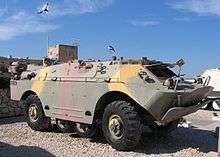
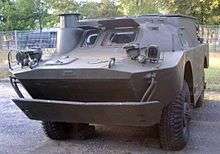
_in_Military-historical_Museum_of_Artillery%2C_Engineer_and_Signal_Corps_in_Saint-Petersburg%2C_Russia.jpg)
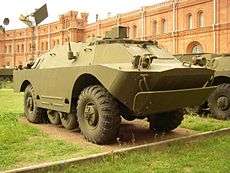

- BRDM-2 – basic reconnaissance vehicle, distinguished by its turret, which is the same as that mounted on the BTR-60PB. The conical turret, which mounts two machine guns (14.5 mm and 7.62 mm), is unusual in that it has no top hatch opening. This model carries a crew of four: the commander, the gunner, the driver, and the co-gunner. It also has a land navigation system that gives co-ordinate readings. Late Production version had mushroom-type vents on top of engine compartment. Final production model had two additional turret periscopes, one on top of turret and the other one on the left hand side of the turret and a TNA-2 navigation apparatus. It was also known under designations BTR-40PB, BTR-40P-2 and GAZ 41-08.[13]
- BRDM-2 without the 14.5 mm KPVT heavy machine gun.[13]
- BRDM-2RKh (khimicheskaya razvedivatel’naya mashina) – radiological-chemical reconnaissance vehicle with two KZO-2 rectangular dispensers for emplacing warning poles and flags around contaminated areas. The pole/flag dispensers are located on the rear corners of the vehicle's hull. The dispensers are normally covered with canvas and when required are positioned vertically over the rear of the vehicle. The specialized equipment consist of an automatic gas detector GSA-12, a dosimeter DP-5V, a röntgenmeter DP-3B, decontamination apparatus DK-4K and semi-automatic detection devices PPKhR and VPKhR. The vehicle retains the original armament. The regimental chemical defence platoon and the divisional-level chemical defence company use it, as the does divisional reconnaissance battalion. It was also known under designations BRDM-2RKhA, BTR-40P-2RKh and BTR-40PB-RKh.[2][4][13]
- BRDM-2RKhb – improved model that can also be used for biological reconnaissance, thanks to specialised equipment including the DP-5B röntgenmeter and biological aerosol detector ASP. BRDM-2RKhb doesn't have the firing ports. This model has twin 7.62 mm PKT general-purpose machine guns instead of the 14.5 mm KPVT heavy machine gun and 7.62 mm PKT coaxial general-purpose machine gun and usually carries only one KZO-2 dispenser. It was also known under designation BRDM-2RKhB.[2]
- BRDM-2UM (mashina upravleniya) – command vehicle without turret; however, it carries a 1 kW generator and extra radios (two R-123 and an R-107, or according to other sources one R-105M, one R-108M and one R-130M). On either side of the upper hull there is a big antenna base. Contrary to general Western belief, this is actually a very rare vehicle primarily built for export.
- 9P122 "Malyutka" – ATGM launcher vehicle with 6x9M14M "Malyutka-M" (AT-3B Sagger B) on an elevatable mount with overhead cover. A total of 14 missiles are carried on board. This model is found in regimental and divisional anti-tank units of MRDs, the anti-tank regiments of combined arms armies (CAA), and in the anti-tank regiment or brigade in the artillery division of a front. It has a crew of 2.
- 9P133 "Malyutka" – this is an improved model with bigger sight 9S446 instead of the original 9S414. The 9P133 can launch the more capable 9M14P "Malyutka-P" (AT-3C Sagger C) and 9M14P1 missiles of which it carries from 16 to 18. It uses SACLOS guidance system. The vehicle also has additional windscreen on the front between the drivers windscreen and the sight mounting.
- 9P124 – ATGM carrier vehicle with 4 radio-guided 9M17M "Skorpion-M" (AT-2B Swatter B) AT missiles on an elevatable mount with overhead cover. In the hull are four more missiles. It uses MCLOS guidance system. The 9P124 has a crew of 2. It was also known under designation BRDM-3.[4][13]
- 9P137 "Flejta" – improved model that uses the 9K8 "Flejta" system which allows usage of 9M19P ATGMs with SACLOS instead of MCLOS guidance. The launcher has 5 rails instead of 4.
- 9P148 "Konkurs" – ATGM launcher vehicle with 5 wire-guided 9M113 "Konkurs" (AT-5 Spandrel). The AT-5 launcher can also fire the 9M111 "Fagot" (AT-4 Spigot) missile. The early production model of 9P148 could only fire 9M113 "Konkurs". The crew reloads the launcher through a small hatch located behind it. The gunner controls the missiles through a sight mounted on the front right of the vehicle. The 9P148 can carry a total of 10 9M111 and 10 9M113 or 14 9M113. From 1996 some Russian 9P148 were fitted with an improved 1PN66 day/night thermal sight. In the West, it was also known under the incorrect designation BRDM-3.[13]
- 9P148 "Konkurs" with the whip antenna mount fitted to the right hand side pistol port. This is the standard production model.
- 9P31 – launcher vehicle for the 9M31 surface-to-air missile, belonging to the 9K31 Strela-1 (NATO: SA-9 "Gaskin") vehicle-mounted low-altitude SAM system. The SAM launching system with quadruple canister replaces the machine gun turret on top of the vehicle, it is capable of 360 degrees traverse and limited elevation. It is lowered for travel. The vehicle doesn't have the belly wheels. The vehicle carries 8 missiles. The crew went down to three (commander, driver and gunner).
- 9P31 with resupply racks on the upper sides of the hull.[13]
- 9P31 fitted with the passive radar detection system 9S12 (FLAT BOX A) and three sensors mounted around the carrier vehicle (one next to the launcher, one on the centre of engine deck and one between windscreens), giving it 360-degree coverage. This system emits no radar energy but can detect radio waves emitted from aircraft, giving the vehicle warning about incoming aircraft and aiding in the acquisition of the target aircraft with the optical system. Typical tactics call for the launch of two missiles against each target to improve the chance of destroying it.[1][2][13]
- ZS-82 (zvukoveshchatel'naya stantsiya) – PsyOps vehicle with a large box speaker array on top of an unarmed turret.[13]
- TM-1 – BRDM-2 armoured scout car converted into a fire and rescue vehicle. It has visual warning device on top of the unarmed turret.[13]
- ATM-1 "Ingul" – civilianised emergency transport vehicle without turret.
Afghanistan
- BRDM-2 converted into an improvised fire support vehicle with a complete 57 mm rocket pod and pylon from aircraft or helicopter mounted upside down on the turret roof. Improvized by Alexander Metla in 1987.[13]
Azerbaijan
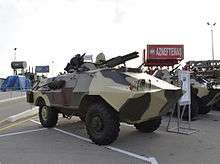
- Azerbaijan's Ministry of Defense led the effort for a local variant of BRDM-2 that is named ZKDM. The layout of the vehicle was completely modified compared to the old BRDM-2, the small windows are removed and the front of the hull is fitted with new armour. The driver is seated at the front of the hull on the left with the vehicle commander to his right. The top of the hull is fitted with two roof hatches immediately behind the commander and driver. One single door is available on each side of the hull. provided by the removal of the small tires on the sides of the vehicle. The single water-jet at the rear of the hull is removed.The gasoline engine of the BRDM2 is replaced with a new diesel engine D-245.30E2 developing 150 hp to increase the maximum road speed of the vehicle to 100 km/h. The ZKDM uses technology of V-hull to increase vehicle and crew survivability by deflecting an upward directed blast from a landmine (or Improvised Explosive Device) away from the vehicle. The body of the ZKDM provides protection level B-32 against armor-piercing incendiary full metal jacket round with a hardened steel core. The ZKDM has a total weight of 7,300 kg with a crew of three, including commander, driver and gunner. The ZKDM is fitted with a new turret armed with a double-barrel, 23 mm GSh-23 cannon, one 7.62 mm PKT machine gun, one 30 mm AGS-17 grenade launchers, four 57 or 80 mm rocket launchers and two smoke grenade launchers mounted on each side of the vehicle. The turret is remotely controlled by the gunner and fitted with fire control system. The weapons have an elevation of +15º, a depression of -30º and the turret can be traversed through a full 360º. Standard equipment of the ZKDM includes BPK-2-42 day/night sight, a TV vision system with a maximum range of 1,000 m, and GPS navigation system GLONASS.[14][15][16]
Belarus
- Alesiya – Modified BRDM-2 for civilian usage as an amphibious armoured truck.[13]
- BRDM-2MB1 – Upgraded BRDM-2 with new diesel engine D245.30E2 of 155 hp for a range of 900 km. The conversion is carried out by the 140th Repair Plant in Borisov.[17]
Bosnia and Herzegovina
- BRDM-2 based tank destroyers converted into APCs.[13]
Cuba
- BRDM-2 converted into a mortar platform. It was recently developed by Cuba. The turret has been removed and a M-38/43 120 mm mortar has been mounted in the modified crew compartment. Three large boxes with ammunition and equipment are located behind the roof opening. Cuban Special Forces "Black Wasps" use the regular BRDM-2 and many of them were seen together with a Cuban made MRAP in the military parade of 2011.[13]
Czech Republic
- LOT-B or BRDM-2/99 (lehký kolový obrněný transportér) – Upgraded model with Renault DCI 4C turbocharged diesel engine with power of 162 hp (121 kW), side hatches, slat-type armour over vision ports, a new NBC protection system, GPS, boxed-in exhausts, six MB smoke grenade dischargers, reworked turret with square extrusion on side, new day/night vision devices and an NSVT 12.7 mm heavy machine gun. The vehicle doesn't have the belly wheels. The vehicle also has a small radio antenna on the left hand side of the hull, next to the driver's hatch. It is also known as BRDM-2NG.[13]
- LOT-VR (velitelská verze) – Command version of the LOT-B with additional signals equipment and a generator.

- OKV-P (obrněné kolové vozidlo pro policii) – Police variant with a turret replaced by a spare wheel and a hatch next to it. It also has side hatches on each side of the hull, bigger armoured windows, police lighting array mounted on the roof, large front bumper with a registration plate, inset head, side and big turn lights, four side observation devices with slotted grills, two on the either side of the hull over the side hatches and two in the front corners of the hull with rear view mirrors in front of them, additional light on the roof, small turn lights on each side of the hull and boxed in exhaust on the left-hand side of the hull's rear.[13]
- BRDM-2RKhb with removed armament from the turret.[13]
- BRDM-2ch – Czech improved BRDM-2RKhb used by radiological and chemical reconnaissance teams. It carriers among other equipment the GSP-11 or GSP-12 Automatic Chemical Agent Detector Alarm, CHP-79 Chemical Agent Detector, IT-65 or DP-86 Radiation Meter, R-123 Radio, KPO-1 Area Marking System and MK-3 Area Marking System. The original armament was replaced with a single 7.62 mm PKT coaxial general-purpose machine gun.[13]
Estonia
- BRDM-2 Politsei – BRDM-2 modified for usage by Estonian Police. The armament has been removed and a police lighting array was placed on top of the turret along with a cover. The firing ports also have been removed. There's also an IR spotlight on top of the turret. There are two periscopes in the left side of the turret. The vehicle has two rear view mirrors.[13] Withdrawn from service.
East Germany
- SPW-40P2 (Schützenpanzerwagen) – NVA designator for BRDM-2. It was also known under designation SPW BRDM-2.[13]
- SPW-40P2(K) – locally developed command version with telescopic mast. It was used by commanders of reconnaissance platoons and companies.[13]
- SPW-40P2 M/F – signals vehicle with R-123MT radio and TNA-3 navigation system.
- SPW-40P2 (Ch) – NVA designator for BRDM-2Rkh.
- SPW-40P2UM – NVA designator for BRDM-2UM.
- SPW-40P2UM fitted with 2x4 mechanical launcher systems for the FLG 5000 illuminating rockets that were operated from within the vehicle. Only one vehicle was modified in 1987.[13]
- SPW-40P2UM fitted with 2x5 mechanical launcher systems for the FLG 5000 illuminating rockets that were operated from outside the vehicle. Only one vehicle was modified in 1987.[13]
Georgia
Modernized by the State Military Scientific-Technical Center “Delta , Modernization includes a number of constructive changes. Instead obsolete weapon system on the vehicle remote control of fighting module 23 mm 2A14 type automatic canon and 7.62mm caliber ПКТ type machine gun paired with it. In the previous projection the armoire is enhanced, two addition doors are molded on the sideboards. On the right and left sideboards 4-4 smoke mortars are installed. In front part of the vehicle night and day vision camera is installed from where the image alights on the installed monitors, in the work places of mechanic-driver and gunner-operator. Triplexes are cancelled, in the right and left corner are added windows for increase of vision areal. In the nose part of the vehicle, special folding knife is added which is intended for cut of wire entanglement wire and wire cables. Engine of the vehicle is also changed. Vehicle can be used as surveillance purposes also for various armament base.[18]
Iraq
- BRDM-2 armed with 23 mm gun with top handle and cylindrical flash eliminator instead of 14.5 mm KPV heavy machine gun and a 7.62 mm PKT coaxial general-purpose machine gun. It was intended to be used for fire support.[13]
- BRDM-2 armed with ZPU-2 twin 14.5 mm antiaircraft heavy machine guns instead of a turret. Also the hull has been stretched. Its intended to be used for fire support and air defense. This vehicle is used by the New Iraqi Army.
Israel
- BRDM-2 converted into an ATGM launcher vehicle with its turret replaced by a pintle mount for a TOW-type ATGM launcher.[13]
Hungary
- BRDM-2 armoured scout car with two rear view mirrors. Used by Hungarian unit of ISAF.[13]
- VS BRDM-2 (vegyi sugárfelderítö úszó gépkocsi) – NBC reconnaissance vehicle. The initial model with the large flat box on top of the engine deck is no longer in service. The current model is very similar to the BRDM-2RKhb, but has a square metal flag dispenser on the right rear. Specialised equipment consists of detection and analysing equipment MK-67P, DS-10, Gid-3, IH-95 and TMF-2.
North Korea
- M1992 – armored personnel carrier influenced by the BRDM-2. Developed in the late 1980s and first observed in 1992. The M1992 has a crew of two and can carry six troops. It is armed with an AGS-17 grenade launcher and AT-4 Spigot ATGM.[19]
Poland
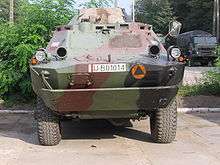

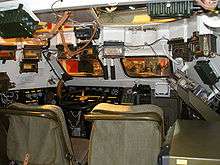

- BRDM-2RS – Polish designation for BRDM-2RKhb.[1]
- BRDM-2 fitted with an IR spotlight in the front of the turret. It was used by Polish unit of SFOR.[13]
- BRDM-2M-96 – The biggest problem with the BRDM-2 pointed out by the Polish crews was the fact that the crew compartment was cramped. To address this issue, the WKMech design team decided to remove the belly wheels and redesign the floor of the vehicle. This gives it much more space for the crew or space for two more soldiers, who can be sent out of the vehicle to recon the surrounding area, thus limiting the possibility of the armoured car falling into a trap set up by the enemy. To ensure the ability to quickly enter and exit the vehicle, doors were added on both sides of the hull. It's fitted with the PNK-72 night vision device for the driver. which during night time operations is used instead of the normal TNP-A day sight. It replaces the original TWN-2B night vision device. The commander has the POD-72 day/night sight, which gives him a 360 degree field of view and is mounted in the front of his cupola. The BRDM-2M-96 also has new seats for the crew, a new generation heater for the engine and fighting compartment, GPS and new communication equipment (including the Sotas internal communication system). It also can carry a spare wheel mounted on the rear of the hull. Designed in 1996. Used by Polish Kosovo Force units.[1][13]
- BRDM-2M-96 fitted with an IR spotlight in the front of the turret. It was used by Polish unit of SFOR.[13]
- BRDM-2M-96 fitted with an IR spotlight in the front of the turret and small IR spotlight over the armament. Used by Polish unit of KFOR.[13]
- BRDM-2M-96i – BRDM-2M-96 with the Iveco Aifo 8040 6-cylinder diesel engine which develops 165 hp (123 kW). It also has new stowage arrangements, two-circuit brake system, 24V electrical system, two rear view mirrors on both sides of the hull and additional protection for its headlights. Designed in 1997.[1][13]
- BRDM-2M-96i fitted with an IR spotlight in the front of the turret. It was used by Polish unit of SFOR.[13]
- ASRAD – German Rheinmetall Defence Electronics ASRAD-R missile air defense system mounted onto the BRDM-2M-96i. Two Polish BRDM-2M-96i were converted into a fire unit and command vehicle with a radar for demonstration purposes at MSPO 2002.[7]
- BRDM-2M-96ik "Szakal" – (Szakal – Jackal) Designed in 2003 by WZMech for the Polish troops in Iraq and Afghanistan. It has the Iveco Aifo 8040SRC 6-cylinder diesel engine, an air conditioning unit mounted on the left side of the hull, new accumulators, Fonet internal communication system, RRC-9500 radio, R-3501 portable radio and .50cal WKM-B heavy machine gun instead of the 14.5 mm KPVT heavy machine gun. The gunner has the new CDN-1 day/night sight.[1][13]
- BRDM-2M-96ik "Szakal" fitted with improvised armour skirts.[20]
- BRDM-2M-96ik "Szakal Plus" – (Szakal – Jackal) Because of the high risk of Polish vehicles in Iraq and Afghanistan getting hit and destroyed or damaged by RPG launchers, in 2004 the WZMech design team fitted it with an RPG fence all around vehicle, anti-cumulation screens, additional armour and internal anti-splinter mats. BRDM-2M-96ik "Szakal Plus" can resist hits 7.62 mm armour piercing rounds, anti-infantry mines and old RPG types like the RPG-7. As a result of all that additional protection, however, the weight of the vehicle went up to 8.5 tonnes. Prototype.[13]
- BRDM-2M-97 "Żbik-B" – BRDM-2M-96i fitted with the Iveco Aifo 8040 SRC-21.11 6-cylinder diesel engine, a 145-litre fuel tank, new transmission system, Deugra fire and explosion protection system, ZPD 24/2 additional power source, Thermo 90DW heater, axial compressor, UNZ-50 inert navigation system with a GPS, AAS-1 Taifos radiation detection system, SSC-1A Obra laser warning system, new NBC system, filtration system, TNPT-1 sight for the commander, heavily modified manually operated turret with a top hatch, armed with 12.7 mm NSVT heavy machine gun (480 rounds) and 7.62 mm PKT coaxial general-purpose machine gun (,2000 rounds). The gunner has a new CDN-1 day/night sight. The new turret allows a greater elevation range for the armament, −4.5 to +32.5 degrees. The turret also has a pintle mount for a 9P135M launcher, which can fire four 9M111 "Fagot" (AT-4 Spigot) or 9M113 "Konkurs" (AT-5 Spandrel) ATGMs. The vehicles fitted with ATGM launcher are known under the designation BRDM-2BF. The turret also has six 81 mm Cytryn smoke grenade launchers in the front of it, in rows of three and a stowage basket in the rear. The vehicle also carries weapons and equipment used by 2–3 man recon squads: 60 mm LM-60K mortar (12 rounds), RPG-7 (10 rounds), 7.62 mm PKM general-purpose machine gun (1,400 rounds), 26 mm wz. 78 flare gun, 18 hand grenades and an LNS laser range-finder. The weight of the vehicle went up to 8 tonnes. The maximum speed decreased from 100 km/h to 90 km/h on the road and from 10 km/h to 4.2 km/h in water. The range of the vehicle decreased to 500 km. The dimensions also increased, the vehicle is now 6.29 m long and 2.43 m high. However, the width and ground clearance of the vehicle decreased as the vehicle is now 2.425 m wide and has a ground clearance of 285 mm. It is also known under the designation BRDM-2B.[1][13]
- BRDM-2M-97C "Żbik-P" – BRDM-2M-97 "Żbik-B" with footplate over side episcopes.[13]
- BRDM-2M-98 "Żbik-A" – Scout company command vehicle version of BRDM-2M-97 "Żbik-B" with more sophisticated reconnaissance equipment, which consists of a BAA electro-optical system made by STN Atlas-Elektronik and an AN/PPS-5C aka SEI MSTAR ground surveillance radar. The vehicle also has additional radio equipment. A prototype underwent trails in 2001. It is also known under designation BRDM-2A.[1][13]
- BRDM-2 R-1A – command and signals vehicle with two R-123Z and one R-107 radio and a telescopic mast. It is used by commanders of anti-tank subunits. In service since 1986.[1]
- BRDM-2 R-5 – command vehicle with R-130 and R-123M radios, R-323 and R-870M receivers (R-870M is used to receive transmissions sent out by the reconnaissance aircraft), two sword antennas and an AZI frame antenna. It also has mounts for a frame antennae on the right side of the top of the hull. BRDM-2 R-5 is used by commanders of reconnaissance units. It can operate evenly with other BRDM-2 armoured scout cars. It has a crew of four (driver, commander, radio operator and gunner). It is also known under the designation BRDM-2D, where "D" stands for "Dowodzenie" – command.[1][13]
Russia
- BRDM-2M – Modernised version. There are actually several upgrades with this designation. All of them have the original gasoline engine replaced by a diesel engine (GAZ-562 of 175 hp or Steyr D.245-9 of 136 hp), six MB smoke grenade dischargers on the back of the turret and some are additionally fitted with a BTR-80 style turret, new wheels, GPS etc. The version that was selected by the Russian armed forces is made by Arzamas. Designated BRDM-2A, it is in service with Russian MVD reconnaissance units.[21] Other models have a new turret MA3 or MA4 that is also mounted on the MT-LBM series. All models have the engine exhaust on the right side of the vehicle only. Some have raised horizontal engine decks to fit the new engines.[13]
- BRDM-2PPM – BRDM-2 converted into a fire and rescue vehicle. The armoured shutters on the front windshields and firing ports have been removed. Two windows have been added on the front corners of the hull. Another four windows have been added on each side of the hull (two per each). Two of the driving lights have been removed. The turret has been replaced with some kind of crate. There are two side hatches. There's a small hatch in the rear, most probably used to make repairs easier.[13]
- Umka – BRDM-2 converted for civil use. The front of the hull has been completely rebuilt as it was replaced by a tall superstructure, tall enough to have an adult man standing inside. The superstructure has two windshields in the front and a window on each of the front hull corners. There are two small windows on each side of the side door. The vehicle also has two rear view mirrors and an additional IR spotlight on the top of the superstructure.[13]
Serbia
- "Kurjak" (Black Wolf) – A Yugoimport SDPR upgrade package. Includes reshaped hull, stronger engine and a remote weapon system platform.[22]
Slovakia
- BRDM-2 fitted with a new engine, new armament and side doors. Belly wheels have been removed.[1]
Ukraine
- BRDM-2D or BRDM-2SMD – by Morozov upgraded version with SMD-21-08 diesel engine with power of 145 hp (108 kW). It also has a new transmission system and new radio equipment. The belly wheels have been removed and side hatches added. In service.[1][23]
- BRDM-2DI – upgrade from NRMZ with IVECO 138 hp diesel engine and side doors. For the first time presented in 2005. Prototype.
United States of America
- BRDM-2 used by the US Army in the OPFOR role. It is fitted with the MILES laser-tag system and the whoopie light to indicate if the vehicle is hit.
Operators

Current operators
_unloads_bulgarian_vehicle.jpg)
-
 Afghanistan – Mostly captured vehicles from the war with the Soviet Union; some were vehicles abandoned by retreating Soviet forces, others were derelict vehicles left by the Soviets all over Afghanistan and brought back to working condition.[13]
Afghanistan – Mostly captured vehicles from the war with the Soviet Union; some were vehicles abandoned by retreating Soviet forces, others were derelict vehicles left by the Soviets all over Afghanistan and brought back to working condition.[13] -
 Algeria – 60 BRDM-2 and 64 9P122 "Malyutka".[24]
Algeria – 60 BRDM-2 and 64 9P122 "Malyutka".[24] -
 Angola – 50
Angola – 50 -
 Armenia – 120
Armenia – 120 -
 Belarus[13]
Belarus[13] -
 Bulgaria – 24+
Bulgaria – 24+ -
 Azerbaijan – 29
Azerbaijan – 29 -
 Bosnia and Herzegovina[13]
Bosnia and Herzegovina[13] -
 Cambodia – 200
Cambodia – 200 -
 Cameroon – 200–300
Cameroon – 200–300 -
 Cape Verde[13]
Cape Verde[13] -
 Ivory Coast – 13 delivered by Belarus between 2002 and 2003.[25]
Ivory Coast – 13 delivered by Belarus between 2002 and 2003.[25] -
 Cuba – 100 BRDM-2 used for the special forces and 50 modernized with a 120 mm mortar
Cuba – 100 BRDM-2 used for the special forces and 50 modernized with a 120 mm mortar -
 Czech Republic – BRDM-2RKh and 9P31
Czech Republic – BRDM-2RKh and 9P31 -
 Djibouti
Djibouti -
 Egypt – 300[26] BRDM-2, BRDM-2UM + 100 modernized to BRDM-2M96i by Poland.
Egypt – 300[26] BRDM-2, BRDM-2UM + 100 modernized to BRDM-2M96i by Poland. -
 Eritrea
Eritrea -
 Estonia – 7
Estonia – 7 -
 Georgia – 17[27]
Georgia – 17[27] -
 Guinea – 4 delivered by Ukraine in 1998.[13][25]
Guinea – 4 delivered by Ukraine in 1998.[13][25] -
 Hungary
Hungary -
 India
India -
 Indonesia
Indonesia -
 Iraq – The Iraqi Army uses a number of BRDM-2 armed with ZPU-2 twin 14.5 mm KPV antiaircraft heavy machine guns (See Iraq section for details).[13] Ukraine delivered 13 BRDM-2 armoured scout cars to the Iraqi Army in 2006.[25] The Iraqi Regular Army operated 1,300 BRDM-1 and BRDM-2 armoured scout cars and vehicles based on them.
Iraq – The Iraqi Army uses a number of BRDM-2 armed with ZPU-2 twin 14.5 mm KPV antiaircraft heavy machine guns (See Iraq section for details).[13] Ukraine delivered 13 BRDM-2 armoured scout cars to the Iraqi Army in 2006.[25] The Iraqi Regular Army operated 1,300 BRDM-1 and BRDM-2 armoured scout cars and vehicles based on them. -
 Latvia – 2 (no more in service).[28]
Latvia – 2 (no more in service).[28] -
 Libya – 350;[1] refurbished by a Czech firm in 2013.[29][30]
Libya – 350;[1] refurbished by a Czech firm in 2013.[29][30] -
 Kurdistan – Peshmerga
Kurdistan – Peshmerga -
 Lithuania – 10 in service as of 2006. 21 delivered by Poland between 1993 and 1995 (10 in 1993 and 11 in 1995).[25]
Lithuania – 10 in service as of 2006. 21 delivered by Poland between 1993 and 1995 (10 in 1993 and 11 in 1995).[25] -
 Macedonia – 10
Macedonia – 10 -
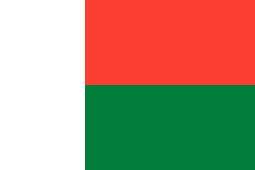 Madagascar - 2
Madagascar - 2 -
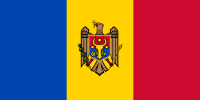 Moldova - 27
Moldova - 27 -
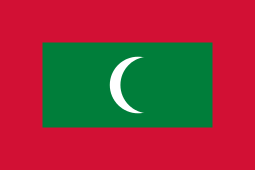 Maldives
Maldives -
 Mali – 20[31] – 64 delivered by URSS and Bulgaria but many of them lost during fights
Mali – 20[31] – 64 delivered by URSS and Bulgaria but many of them lost during fights -
 Mongolia – 120 BRDM-2 and BRDM-2Rkh[32]
Mongolia – 120 BRDM-2 and BRDM-2Rkh[32] -
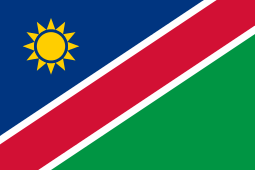 Namibia – 12 total in use with the Namibian Defence Force, most inherited directly from PLAN or captured models in the custody of the former South West African administration.[33]
Namibia – 12 total in use with the Namibian Defence Force, most inherited directly from PLAN or captured models in the custody of the former South West African administration.[33] -
 North Korea
North Korea -
 Palestine – 45 BRDM-2 delivered by Russia to the Palestinian Authority Police in 1995,[34] later seized by Hamas following the Battle of Gaza in June 2007.
Palestine – 45 BRDM-2 delivered by Russia to the Palestinian Authority Police in 1995,[34] later seized by Hamas following the Battle of Gaza in June 2007. -
 Pakistan – Captured from Afghan government forces & brought to Pakistan after the Soviet Afghan war. Currently in Reserve.
Pakistan – Captured from Afghan government forces & brought to Pakistan after the Soviet Afghan war. Currently in Reserve. -
 Peru – Late production BDRM-2 model and 9P133 ATGM launcher.
Peru – Late production BDRM-2 model and 9P133 ATGM launcher. -
 Poland – 200 BRDM-2s, 120 BRDM-2s modernized to BRDM-2M-96, BRDM-2M-96i, BRDM-2M-97 "Żbik-B" and BRDM-2M-98 "Żbik-A" level, 22 BRDM-2s modernized to BRDM-2M-96ik "Szakal" level, 100 9P133 "Malyutka" and 18 9P148 "Konkurs" tank destroyers, a dozen of BRDM-2RS NBC reconnaissance vehicles, an unknown number of 9K31 Strela-1 self-propelled surface-to-air missile launchers as well as BRDM-2 R-1A and BRDM-2 R-5 command vehicles.[1][6][10]
Poland – 200 BRDM-2s, 120 BRDM-2s modernized to BRDM-2M-96, BRDM-2M-96i, BRDM-2M-97 "Żbik-B" and BRDM-2M-98 "Żbik-A" level, 22 BRDM-2s modernized to BRDM-2M-96ik "Szakal" level, 100 9P133 "Malyutka" and 18 9P148 "Konkurs" tank destroyers, a dozen of BRDM-2RS NBC reconnaissance vehicles, an unknown number of 9K31 Strela-1 self-propelled surface-to-air missile launchers as well as BRDM-2 R-1A and BRDM-2 R-5 command vehicles.[1][6][10] -
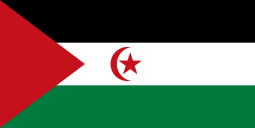 Sahrawi Arab Democratic Republic – Late production BDRM-2 model and 9P31 SAM launcher.[13]
Sahrawi Arab Democratic Republic – Late production BDRM-2 model and 9P31 SAM launcher.[13]


-
 Romania – 138 (12 9P122 "Malyutka", 78 9P133 "Malyutka" and 48 9P148 Konkurs)[35]
Romania – 138 (12 9P122 "Malyutka", 78 9P133 "Malyutka" and 48 9P148 Konkurs)[35] -
 Russia – 2,000 as of 2011.[36] Around 2,080 as of 2013.[37]
Russia – 2,000 as of 2011.[36] Around 2,080 as of 2013.[37] -
 Serbia – 76
Serbia – 76 -
 Slovakia[1]
Slovakia[1] -
 Slovenia – 5 late production BDRM-2s. Command company of 44th Armored-mechanized Battalion "Wolves" operates BRDM-2 vehicles.[38]
Slovenia – 5 late production BDRM-2s. Command company of 44th Armored-mechanized Battalion "Wolves" operates BRDM-2 vehicles.[38] -
 Sudan – 60 delivered by Belarus between 2003 and 2004 (39 in 2003 and 21 in 2004).[25]
Sudan – 60 delivered by Belarus between 2003 and 2004 (39 in 2003 and 21 in 2004).[25] -
 Syria – 950
Syria – 950 -
 Somalia
Somalia -
 Turkmenistan – 30[39]
Turkmenistan – 30[39] -
 Ukraine – Delivered 13 BRDM-2 armoured scout cars to the New Iraqi Army in 2006.[25]
Ukraine – Delivered 13 BRDM-2 armoured scout cars to the New Iraqi Army in 2006.[25] -
 Vietnam – 200
Vietnam – 200 -
 Zambia
Zambia -
 Zimbabwe
Zimbabwe
Former operators
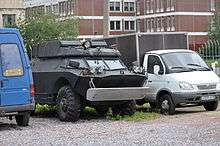
- Al-Murabitun – operated ex-PLO vehicles in Lebanon (1983–86).
-
 Albania – 30 BRDM-1 and BRDM-2, all withdrawn
Albania – 30 BRDM-1 and BRDM-2, all withdrawn -
 Czechoslovakia – Passed on to the successor states.
Czechoslovakia – Passed on to the successor states. -
 Croatia – 9
Croatia – 9 -
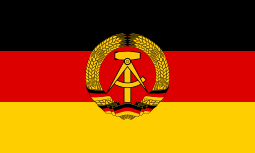 East Germany – Passed on to the unified German state.
East Germany – Passed on to the unified German state. -
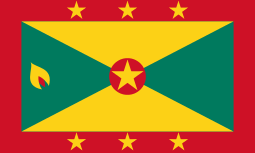 Grenada – 2 BRDM-2 were delivered by the Soviet Union to Grenada in 1981 or 1982.
Grenada – 2 BRDM-2 were delivered by the Soviet Union to Grenada in 1981 or 1982. -
 Soviet Union – Passed on to the successor states.
Soviet Union – Passed on to the successor states. -
 Germany – taken from GDR's army, all scrapped or sold to other countries.
Germany – taken from GDR's army, all scrapped or sold to other countries. -
 Palestine – Unknown number operated by the PLO in Lebanon and passed on to the Al-Murabitun in 1983.
Palestine – Unknown number operated by the PLO in Lebanon and passed on to the Al-Murabitun in 1983. - South Lebanon Army – Captured vehicles supplied by Israel.
-
 Yugoslavia – Passed on to successor states.
Yugoslavia – Passed on to successor states.
See also
References
- 1 2 3 4 5 6 7 8 9 10 11 12 13 14 15 16 17 18 19 20 21 22 23 24 25 26 27 28 29 30 31 "Samochód opancerzony BRDM-2", Militarium.net (in Polish), retrieved 21 September 2011
- 1 2 3 4 5 6 7 8 9 10 11 12 13 14 15 16 17 18 "Gary's Combat Vehicle Reference Guide". Inetres.com (6 April 2009). Retrieved on 21 September 2011.
- ↑ Notes on the Soviet Ground Forces, 70735, Ministry of Defence, OCLC 506052583
- 1 2 3 4 "FAS". "FAS". Retrieved on 21 September 2011.
- ↑ Archived 11 May 2005 at the Wayback Machine.
- 1 2 2. Militarium.net (18 August 2008). Retrieved on 21 September 2011.
- 1 2 Newsline 4/2001. (PDF). Retrieved on 21 September 2011.
- ↑ Army Recognition Alain Servaes. "Land Combat Expo 2004 Pictures picture photo image Military Exhibition of latest high military technology Patrick Henry village Heidelberg Germany United States Army salon militaire sur les dernières technologies militaires de l'arme américaine Heidelberg Allemagne". Retrieved 4 November 2014.
- ↑ MON. MON. Retrieved on 21 September 2011.
- 1 2 Altair – R-wto 03/2007 – Kołowa aberracja. Altair.com.pl. Retrieved on 21 September 2011.
- ↑ Steenkamp, Willem (2006) [1985]. Borderstrike! South Africa into Angola. 1975-1980 (3rd ed.). Durban, South Africa: Just Done Productions Publishing (published 1 March 2006). ISBN 978-1-920169-00-8. Retrieved 29 September 2014.
- ↑ First Battle of Mariupol
- 1 2 3 4 5 6 7 8 9 10 11 12 13 14 15 16 17 18 19 20 21 22 23 24 25 26 27 28 29 30 31 32 33 34 35 36 37 38 39 40 41 42 43 44 45 46 47 "JED The Military Equipment Directory"(registration required)
- ↑ ""Ronaldo" — Azerbaijani modernization BRDM-2". Retrieved 6 December 2015.
- ↑ "Azerbaijan's BRDM-2 Upgrade: ZKDM". Retrieved 6 December 2015.
- ↑ "Azerbaijan maintains modernization of BTR-70 and BRDM-2". Retrieved 6 December 2015.
- ↑ БРДМ-2МБ1 – МОДЕРНИЗАЦИЯ БРДМ-2 – ОАО "140 Ремонтный завод". 140zavod.org (24 February 2011). Retrieved on 21 September 2011.
- ↑ Modernization programme of widely spread armored reconnaissance vehicle BRDM-2 by Delta in Georgia".
- ↑ M1992 – Military-Today.com
- ↑ http://img142.imageshack.us/img142/8722/irak22rp.jpg
- ↑ http://www.arms-expo.ru/049051124051052052050051.html
- ↑ "Kurjak" armyrecognition.com
- ↑ KMDB – Modernization of the BRDM-2 armoured reconnaissance vehicle. Morozov.com.ua. Retrieved on 21 September 2011.
- ↑ Algerian army Archived 29 May 2009 at the Wayback Machine. armyrecognition.com
- 1 2 3 4 5 6 Deagel BRDM-2. Deagel.com (10 March 2011). Retrieved on 21 September 2011.
- ↑ Egyptian army armyrecognition.com
- ↑ "Armament of the Georgian Army". Geo-army.ge. Archived from the original on 9 March 2012. Retrieved 2012-02-27.
- ↑ "Baltijas valstu armijas: Igaunijai 88 bruņutransportieri, Lietuvai 197, Latvijai – 0". nra.lv. Retrieved 4 November 2014.
- ↑ "$52m Czech Deal with Libyan Military". Retrieved 4 November 2014.
- ↑ Czech firms arrange deal to sell armoured vehicles to Libya
- ↑ Malian army land ground armed forces. ArmyRecognition.com. Retrieved on 2013-02-11.
- ↑ Армии стран мира : Вооруженные силы иностранных государств на 2001 год : М. Soldiering.ru. Retrieved on 2012-12-19.
- ↑ http://www.iss.co.za/Af/profiles/Namibia/SecInfo.html
- ↑ Eric Micheletii & Jérôme Palmade, 'L'Autorité Palestinienne et la nouvelle Intifada' in 'Israel-Palestine – L'Appel aux Armes', RAIDS Hors-Serie nº2, Histoire & Collections, Paris 2000, PP. 54–56. (in French)
- ↑ IISS Military Balance 2010. Iiss.org. Retrieved on 21 September 2011.
- ↑ Russian Army Equipment. Globalsecurity.org. Retrieved on 21 September 2011.
- ↑ BRDM-2. Russian Military Analysis. Retrieved on 26 September 2013.
- ↑ 44. Armored-mechanized Battalion. Vojska.net. Retrieved on 21 September 2011.
- ↑ Turkmen-Army Equipment. Globalsecurity.org. Retrieved on 21 September 2011.
- Gau L-R., Plate J., Siegert J. (2001) Deutsche Militärfahrzeuge – Bundeswehr und NVA. Motorbuch Verlag. ISBN 3-613-02152-8
External links
| Wikimedia Commons has media related to BRDM-2. |
- BRDM variants – Walk arounds and photos on Prime Portal
- fas.org
- BRDM-2 Technical data sheet and pictures to Army Recognition site